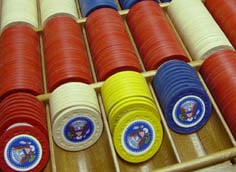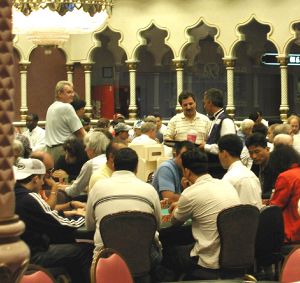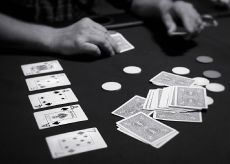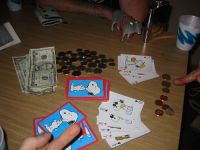Poker
- For the domestic fireplace tool, see fireplace poker.
Poker refers to a popular card game, or group of card games, in which players compete against one another by holding one or more playing cards and gambling on the values of each player's hand by betting into a central pot. The objective is to win the central pot either by holding the superior hand at the end of the round or by betting and forcing the other players to fold, or discard their hand.
There are many variations on the game of poker, all of which follow a similar pattern of play: dealing, betting, and showing, often with more than one round of dealing or betting, which help to change players' hand values. Some forms of poker, especially Texas Hold'em, involve a combination of concealed and community cards which make up the players' hands.
Poker has become a very popular online and casino gambling game, including non-traditional forms of poker which use the same basic rules and hand rankings, such as video poker and three-card poker. In these games, players do not play against one another, but against a house or computer opponent.
Game play
Poker play typically follows a certain basic set of rules, regardless of the specific form. The right to deal hands is usually passed from one player to another in a clockwise fashion, and often times a round dealer "button" or token (sometimes called a "buck") circles along with the dealing responsibility. In a casino, a dealer will deal every hand, while passing the dealer "button" at the end of each hand to rotate dealer position. In most games, the dealer position results in being last to act during the betting rounds.
Before cards are even dealt, one or more players are typically required to make "forced bets" to create the initial stake, or "pot", for which the players compete. These might be "antes", which are small bets made by each player and placed into the pot, or "blinds", found in popular hold 'em varieties. The "blinds" are two successive, increasing bets made by the players to the immediate left of the dealer and establish the minimum bet for that round. The dealer then deals the cards to the players one at a time, either face up for face down, depending on the style of the game. After the deal, players may bet, check, call, raise, or fold in accordance with the strategy of the game, adding money or chips to an ever-increasing pot. Subsequent rounds might feature the addition or exchange of cards in players' hands, changing their value and affecting the individual's playing style.
These are the differences between the actions:
- Bet - a "bet" is a move in which a player puts money into the pot, establishing the initial amount to be matched by the successive players. Only the first move is called the "bet". In varieties such as no-limit, players may bet all of their chips into the pot. This would be called "betting all-in". If one player bets and nobody calls or raises, he automatically wins the pot as the last remaining player.
- Check - when there is no established bet, players have the option of "checking" and letting the next player make a move. If every player checks, the hand continues to the next round with no changes to the pot size.
- Call - if there is a bet or raise made, a player can "call" the bet by matching the amount and putting it into the pot.
- Raise - if one player has made a bet into the pot, another may "raise" the action by pushing an amount greater than the initial bet into the pot. If this action occurs more than once, subsequent bets are considered "re-raises".
- Fold - a player may decide not to continue any further in the hand, choosing not to match a bet and "folding" his hand by tossing the cards into the muck and forfeiting any right to the pot.
Because poker involves bets of concealed hand values, bluffing becomes an important tactic in an attempt to win pots. Players can force one another out of hands by betting or raising, even when they are holding cards with little to no value. A bluff would be successful when a player, who would have normally lost the hand based on card value, wins by betting enough to force the other players out of the hand. And with the winner's option of concealing his cards, bluffs can become more valuable by going unnoticed.
If more than one player remains in the hand at the end of the last betting round, there is a "showdown", in which the players reveal the previously concealed cards to evaluate their hands. If there has been a bet, typically the player making the initial bet acts first by turning over his cards, and the other players follow suit. The player with the best hand showing according to the style of poker being played then wins the pot. (Or in some cases, like Omaha Hi-Lo Split, the best hand will split the pot with the worst hand.)
Hand Rankings
There are four suits: clubs, diamonds, hearts, and spades; and thirteen rank cards, including numerals 2 through 10, the Jack (J), Queen (Q), King (K), and Ace (A). The common poker hand rankings are as follows, listed from strongest to weakest (with a standard 52-card deck and no "wild" cards):
1. Straight Flush - five consecutive cards of the same suit, such as the 5-6-7-8-9, all of diamonds. The 10-J-Q-K-A of one suit is called a "Royal Flush" and is an unbeatable hand.
2. Four of a Kind - also known as "quads", this is any four cards of matching rank. A-A-A-A would be a better four of a kind than 8-8-8-8.
3. Full House - sometimes referred to as a "boat", this is any three cards of matching rank in combination with any two cards of matching rank, like 6-6-6-Q-Q. In this case, the hand would be called "sixes full of queens", as there are three sixes and two queens. If there is more than one full house in a hand, the winner is determined first by the rank of that player's three matching cards, then by the rank of that player's two matching cards. For instance, J-J-J-10-10 is better than 10-10-10-K-K, but inferior to J-J-J-A-A.
4. Flush - any five cards of matching suit. The winner of two flushes is determined by comparing the players' highest cards in successive order. For instance, A-K-2-3-4 of hearts would be a winning hand over A-Q-J-10-5 of diamonds.
5. Straight - any five consecutive rank cards, regardless of suit. In this situation, the Ace is commonly played as both a low and a high card. A-2-3-4-5 is considered a straight, as well as 10-J-Q-K-A. Two or more straights are valued in terms of their highest cards.
6. Three of a Kind - also known as "trips" or a "set", three of a kind is any three matching rank cards, just like four of a kind.
7. Two Pair - a hand consisting of two matching pairs of rank cards, such as A-A-10-10. Multiple two pair hands are valued first by the individual hand's higher pair, then by its lower. For example, A-A-3-3 would beat K-K-Q-Q but lose to A-A-5-5.
8. One Pair - a hand with two matching rank cards. Pairs are measured in terms of the value of the two matching rank cards, eg. A-A is better than Q-Q.
9. High Card - when there are no pairs, flushes, or straights, the winning hand is determined by the strongest valued card, from 2 (the lowest) to A (the highest). If two players have matching high cards, their next highest card determines the winner. Similarly, if players have matching hands of one pair, two pair, three of a kind, or four of a kind, the next highest cards in each player's hand is used to determine the winner. This is called playing a "kicker". An Ace would be considered an unbeatable kicker.
Game Variants
As a playing card game that has developed over the years with many interpretations and styles of play, numerous recognized forms of poker exist as individualized games today. In addition to the well-known games, house rules and specialized varieties expand the possible forms to unknown quantities. The most popular poker variants are as follows:
- Draw Poker: long a favorite at home games, players receive five or more cards (the most common forms are Five-Card Draw and Seven-Card Draw), all of which remain hidden to the other players. In succession, they may then replace one or more of their cards with new cards from the deck, if they so choose. Draw varieties that involve betting commonly have at least two rounds of betting—once the cards have been dealt and once the cards have been re-drawn. For a long stretch of time, Five-Card Draw was the game of choice almost everywhere, but in recent years the popularity of the game has been overshadowed by other more aggressive forms.
- Stud Poker: another one of the early forms of poker, Stud evolved mainly in the Five- and Seven-Card varieties. The difference between Stud and Draw is that players may not exchange their individual cards for new ones from the deck. In the casino Seven-Card form of the game, cards are dealt two down and one up in the first round, then three more face up with betting rounds following each, and the final card face down. Players use five of their seven cards to make the best hand.
Draw poker:Players each receive five — as in five-card draw — or more cards, all of which are hidden. They can then replace one or more of these cards a certain number of times.
- Stud poker
- Players receive cards one at a time, some being displayed to other players at the table. The key difference between stud and 'draw' poker is that players are not allowed to discard or replace any cards.
- Community card poker
- Players combine individually dealt cards with a number of "community cards" dealt face up and shared by all players. Each player will attempt to make the best five card poker hand using the community cards and their own face down cards. Two or four individual cards may be dealt in the most popular variations, Texas hold 'em and Omaha hold 'em, respectively.
History
The history of poker is a matter of debate. It closely resembles the Persian game of as nas, and may have been taught to French settlers in New Orleans by Persian sailors. The name of the game likely descended from the French poque, which descended from the German pochen ('to knock'). Yet it is not clear whether the origins of poker itself lie with the games bearing those names. It is commonly regarded as sharing ancestry with the Renaissance game of primero and the French brelan. The English game brag (earlier bragg) clearly descended from brelan and incorporated bluffing (though the concept was known in other games by that time). It is quite possible that all of these earlier games influenced the development of poker as it exists now.
English actor Joseph Crowell reported that the game was played in New Orleans in 1829, with a deck of 20 cards and four players betting on which player's hand was the most valuable. Jonathan H. Green's book, An Exposure of the Arts and Miseries of Gambling (G. B. Zieber, Philadelphia, 1843), described the spread of the game from there to the rest of the country by Mississippi riverboats, on which gambling was a common pastime. As it spread up the Mississippi and West during the gold rush, it is thought to have become a part of the frontier pioneer ethos.

Soon after this spread, the full 52-card English deck was used, and the flush was introduced. During the American Civil War, many additions were made, including draw poker, stud poker (the five-card variant), and the straight. Further American developments followed, such as the wild card (around 1875), lowball and split-pot poker (around 1900), and community card poker games (around 1925). The spread of the game to other countries, particularly in Asia, is often attributed to the U.S. military.
The game and jargon of poker have become important parts of American culture and English culture. Such phrases and clichés as ace in the hole, ace up one's sleeve, beats me, blue chip, call one's bluff, cash in, high roller, pass the buck, poker face, stack up, up the ante, when the chips are down, wild card, and others are used in everyday conversation, even by those unaware of their origins at the poker table.

Modern tournament play became popular in American casinos after the World Series of Poker began, in 1970. Notable champions from these early WSOP tournaments include Johnny Moss, Amarillo Slim, Bobby Baldwin, and Doyle Brunson. It was also during that decade that the first serious strategy books appeared, notably Super/System by Doyle Brunson (ISBN 1-58042-081-8) and The Book of Tells by Mike Caro (ISBN 0-89746-100-2), followed later by The Theory of Poker by David Sklansky (ISBN 1-880685-00-0).
Poker’s popularity experienced an unprecedented spike at the beginning of the 21st century, largely because of the introduction of online poker and the invention of the hole-card camera, which turned the game into a spectator sport. Viewers could now follow the action and drama of the game, and broadcasts of poker tournaments such as the World Series of Poker and the World Poker Tour brought in huge audiences for cable and satellite TV distributors. Because of the increasing coverage of poker events, poker pros are becoming more and more like celebrities, with poker fans all over the world entering into expensive tournaments for the chance to play with them. This increased camera exposure also brings a new dimension to the poker professional's game—the realization that their actions may be aired later on TV.
Major poker tournament fields have grown dramatically because of the growing popularity of online satellite-qualifier tournaments where the prize is an entry into a major tournament. The 2003 and 2004 WSOP champions, Chris Moneymaker and Greg Raymer, respectively, won their seats to the main event by winning online satellites.
See also
- List of poker terms
- Poker hand rankings
- List of poker related topics
- Rule variations (poker)
- Poker tournament
- Poker strategy
- World Series of Poker
- Poker probability
- Online poker
- Ring games
- Poker chip
- Poker room/card room
ReferencesISBN links support NWE through referral fees
- Brunson, Doyle (1979). Doyle Brunson's Super System. Cardoza. ISBN 1-58042-081-8.
- Sklansky, David (1989). The Theory of Poker (3rd Ed). Two Plus Two Publications. ISBN 1-880685-00-0.
- Vorhaus, John (2002). Killer Poker. Lyle Stuart. ISBN 0-8184-0630-5.
- Ernest, James; Selinker, Mike; Foglio, Phil (2005). Dealer's Choice: The Complete Handbook of Saturday Night Poker. Overlook Press. ISBN 1-58567-654-3.
- Caro, Mike (1978). Caro's Book of Poker Tells. Cardoza. ISBN 1-58042-082-6.
External links
Credits
New World Encyclopedia writers and editors rewrote and completed the Wikipedia article in accordance with New World Encyclopedia standards. This article abides by terms of the Creative Commons CC-by-sa 3.0 License (CC-by-sa), which may be used and disseminated with proper attribution. Credit is due under the terms of this license that can reference both the New World Encyclopedia contributors and the selfless volunteer contributors of the Wikimedia Foundation. To cite this article click here for a list of acceptable citing formats.The history of earlier contributions by wikipedians is accessible to researchers here:
The history of this article since it was imported to New World Encyclopedia:
Note: Some restrictions may apply to use of individual images which are separately licensed.



